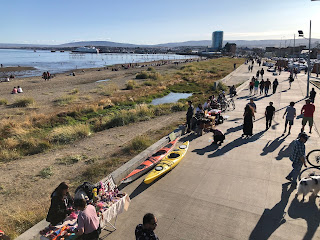4. Annie Proulx, The Shipping News (1993) (2/28/2020)
I first read this book many years ago and was blown away: by the poetry of the prose, the substance of the characters, the drama and humor and poignancy of the lives portrayed, the sweep of the Newfoundland landscape. On this second read, I was perhaps even more impressed, especially on the drama-humor-poignancy front—and perhaps a little less so on the poetry-of-the-prose front: too many sentence fragments made me conscious of the artistry, which is not such a good thing. I was reminded of a 2001 Atlantic article by one B. R. Myers titled "A Reader's Manifesto: An Attack on the Growing Pretentiousness of American Literary Prose," in which he tears apart (among others') Proulx's writing. (But also consider a rebuttal some years later by one Garth Risk Hallberg titled "The Soul-Sucking Suckiness of B. R. Myers," which tears apart Myers's tearing-apart. Everything in moderation, I guess.) I think one just has to relax a bit and not be too literal-minded when reading Proulx; but that still doesn't let her off the hook for all those fragments, not this time around. (The cover I show here is the cover of the book I read way back when. The cover of the recent book features the movie stars—Julianne Moore, Judi Dench, and, unfortunately, Kevin Spacey. I'm glad not to have to look at his mug anymore, now that I'm done with the book.)In any case, a few of the other things I enjoyed—again—about The Shipping News were the use of The Ashley Book of Knots (a volume Proulx found at a garage sale) as thematic grist; the peppering of humorous would-be newspaper headlines to underscore the hero, Quoyle's, bumbling humanity; the very understated way Quoyle and Wavey Prowse fall in love (and even have sex); the backdrop of the sea and fishing, and of the newspaper biz. Very little adds up to plot in this book—but a heckuvalot happens, all of it adding up to life negotiated, puzzled out, lived. It's a quiet progression, the story of a man learning how to belong, how to be content—how, finally, to find love and life "without pain or misery."
I marked two passages for the prose, though I could have marked many, many more. The first struck me for the beauty of characterization through detail:
Suddenly he could see his father, see the trail of ground cherry husks leading from the garden around the edge of the lawn where he walked while he ate them. The man had a passion for fruit. Quoyle remembered purple-brown seckle pears and size and shape of figs, his father taking the meat off with pecking bites, the smell of fruit in their house, litter of cores and peels in the ashtrays, the grape cluster skeletons, peach stones like hens' brains on the windowsill, the glove of banana peel on the car dashboard. In the sawdust on the basement workbench galaxies of seeds and pits, cherry stones, long white date pits like spaceships. Strawberries in the refrigerator, and in June the car parked on a country road and the father on his knees picking wild strawberries in the weeks. The hollowed grapefruit skullcaps, cracked globes of tangerine peel.The second struck me for the social commentary:
Other fathers took their sons on fishing and camping trips, but Quoyle and his brother had blueberry expeditions. They whined with rage as the father disappeared into the bushes, leaving them in the sour heat holding plastic constainers. . . .
The man spent hours in the garden. How many times, thought Quoyle, had his father leaned on his hoe and gazed down the rows of string beans, saying "Some sweet land we got here, boy." He'd thought it was the immigrant's patriotic sentiment, but now balanced it against the scoured childhood on a salt-washed rock. His father had been enchanted with deep soil. Should have been a farmer.
"Billy said to tell you there's a rumor Sea Song might be closing three plants next month. Said he hears No Name might be one."(I have had The Shipping News in mind ever since this post of mine, about knots.)
"Jesus! You think it can't get worse, it gets worse! This business about allocating fish quotas as if they was rows of potatoes you could dig. If there's no fish you can't allocate them and you can't catch them; if you don't catch them, you can't process them or ship them, you don't have a living for nobody. Nobody understand their crazy rules no more. Stumble along. They say 'too many local fishermen for not enough fish.' Well, where has the fish gone? To the Russians, the French, the Japs, West Germany, Easy Germany, Poland, Portugal, the UK, Spain, Romania, Bulgaria—or whatever they call them countries nowadays.
"And even after the limit was set the inshore was no good. How can the fish come inshore if the trawlers and draggers gets 'em all fifty, a hundred mile out? And the long-liner gets the rest twenty mile out? What's left for the inshore fishermen?" He spat in the water. . . .
"Fishery problem? Fuckin' terrible problem. They've made the inshore fishermen just like migrant farm workers. All we do is harvest the product. Moves from one crop to another, picks what they tells us. Takes what they pays us. We got no control over any of the fishery now. We don't make the decisions, just does what we're told where and when we're told. We lives by rules made somewhere else by sons a bitches don't know nothin' about this place." A hard exhalation rather than a sigh.
But, Quoyle thought, that's how it was everywhere. Jack was lucky he'd escaped so long.























